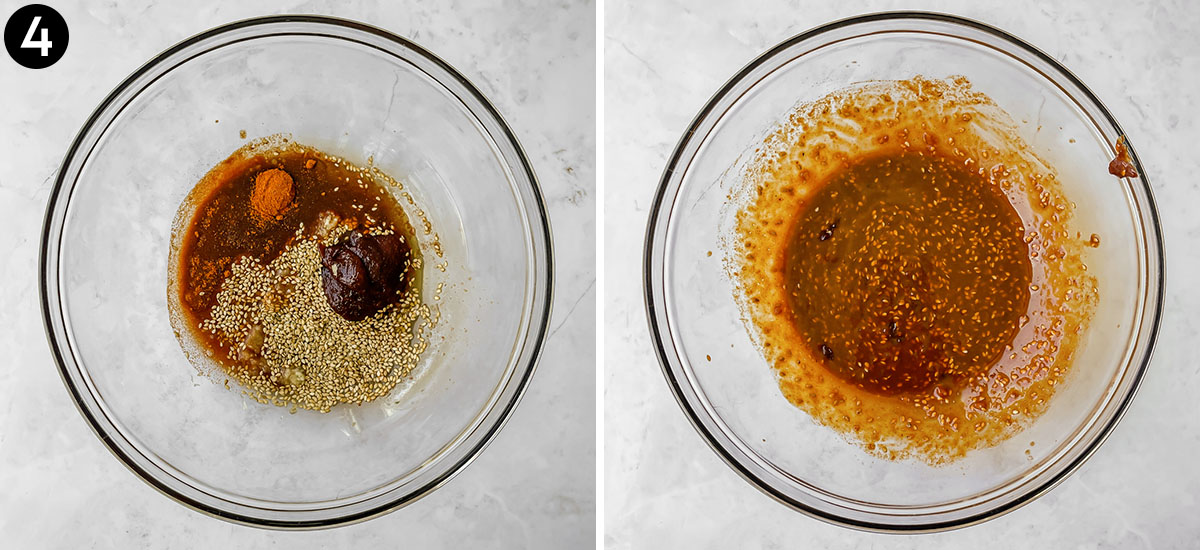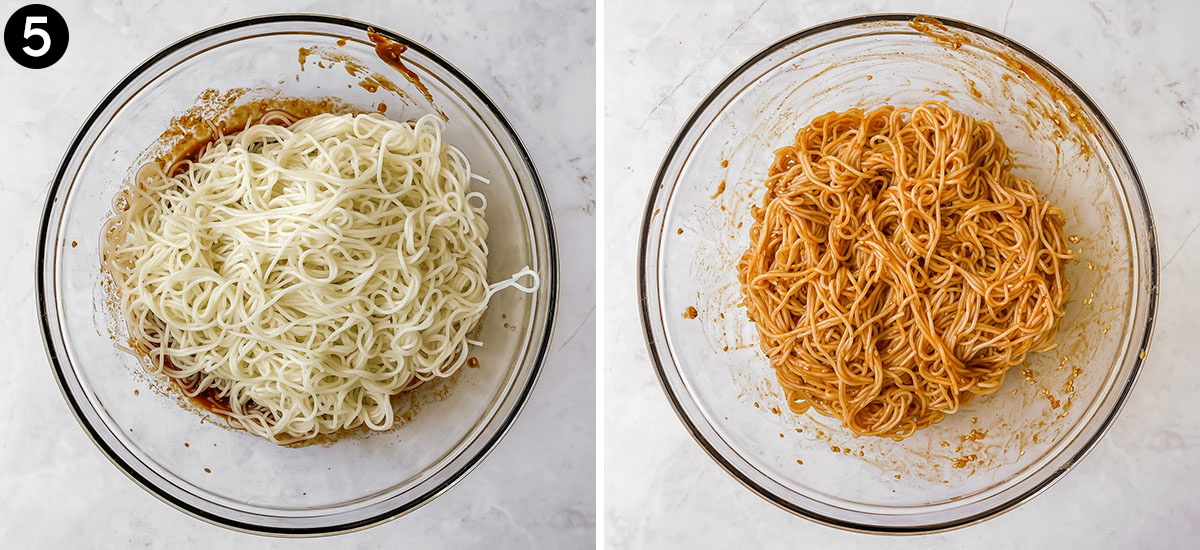Kimchi Bibimmyeon, or Korean Cold Spicy Noodles, is your answer to a blistering hot summer day! Chewy noodles are coated in a spicy, savory, and tangy red sauce that's simple to prepare. This refreshing Korean dish is perfect for when you need dinner on the table in just 15 minutes!

Jump to:
🍜 What Does Bibimmyeon Mean?
You may have heard of bibimbap, a popular Korean dish that consists of rice, a spicy red sauce, and a variety of vegetables. Bibim means "mixed" while bap translates to "rice". So can you guess what bibimmyeon means? Yup - "mixed noodles", with bibim meaning mixed and myeon meaning noodles.
Cold noodles are well-loved in Korean cuisine! There's mul-naengmyeon (Korean buckwheat noodles in a chilled broth) and its sister, bibim naengmyeon (buckwheat noodles with spicy sauce). There's also bibim guksu, which is a term I use interchangeably with bibimmyeon. "Guksu" refers to wheat noodles, which are what I prefer to use in this recipe as well. No matter what you call these Korean spicy noodles, they're a sure winner!
The Best Spicy Cold Noodles
To me, kimchi bibimmyeon is the ultimate summer comfort food. In Asian culture, spicy dishes are very popular on hot days because capsaicin (the spicy component in chilis) increases your metabolism, which causes you to sweat to cool your body down. Some of my favorite spicy Korean recipes include Gochujang Salmon, Instant Pot Dakdoritang, and Korean Shrimp Tacos.
In bibim guksu, chewy cold noodles are dressed in the perfect amount of red chili sauce. It's perfectly tangy and savory, with a hint of sweetness and nuttiness from the sesame seeds. Sliced cucumbers, kimchi, and a hard boiled egg keep the dish hearty yet light.
And because this spicy noodle dish is also great at room temperature, it's perfect to pack for lunch, picnics, or parties! Even though there are instant noodle versions available, homemade always tastes better. And it's so easy anyway! You only need 15 minutes and about 12 ingredients, so there's no excuse to make this delicious bibim guksu today!
Why You'll Love It
- Minimal cooking: When it's hot out, you don't want to spend a lot of time in a hot kitchen. Luckily, Korean spicy cold noodles only requires 5ish minutes of active cooking and the rest is assembly!
- Quick and easy: This 15 minute recipe is very simple with 3 main steps: cook the noodles, make the sauce, and top it off. Done!
- Refreshing: Cold noodles and fresh vegetables keep you cool when it's hot out. This spicy Asian dish is hearty and satisfying, yet bright and tangy.
🧂 Ingredients

- Somyeon (somen): Thin wheat noodles are traditionally used in this dish. Avoid the bags with a seasoning packet - they're not needed.
- Garlic, soy sauce, white sugar, rice wine vinegar, sesame seeds, and sesame oil: flavoring components of the sauce.
- Kimchi: Aged kimchi is more fermented, complex, and sour while fresh kimchi is crunchier and brighter. I prefer to cook with aged kimchi and save fresh kimchi to eat on its own, but either will work in bibimmyeon. Also, each brand of kimchi tastes different so experiment to find the right balance for your sauce.
- Gochugaru: Korean ground chili flakes come in a variety of texture and spice. I like to use finely ground powder for this sauce.
- Gochujang: Fermented Korean chili paste that's smoky, spicy, sweet, and funky. There are varying levels of spice for this ingredient as well.
For The Toppings
- Eggs: Medium to hard-boiled eggs work best as a topping.
- Cucumber: Use Persian cucumbers, which are smaller with thinner skins and edible seeds.
Substitutions & Variations
- If you can't find somyeon noodles, try soba (buckwheat), egg, ramen, or rice noodles in its place. Honestly, any type of thin noodles would work in this recipe.
- Feel free to replace the white sugar with brown sugar, honey, or oligo syrup.
- Rice wine vinegar can be substituted with apple cider vinegar or mirin for a slightly sweeter taste.
- To make a less spicy bibimmyeon, use the mild versions of gochugaru and gochujang. Also halve the gochugaru and adjust as needed. If it's still too spicy after mixing with the noodles, you can dilute the spice with broth and a splash more vinegar.
- If you want to add meat, try shredded chicken, steamed shrimp, or a firm flaky fish like tilapia.
- Add more vegetables for a heartier dish. Perilla leaves, scallions, Korean radish, bean sprouts, carrots, or cabbage would taste great.
- To make this gluten-free, use rice noodles, gluten free ramen, or any alternative spaghetti. Replace the soy sauce with tamari or coconut aminos and use a gluten-free gochujang. Also double-check the ingredients in your kimchi.
- To make this vegetarian, make sure the kimchi doesn't use any seafood ingredients.
🔪 How To Make Korean Cold Spicy Noodles
⬇️ Please scroll down to the recipe card to see full ingredient amounts and instructions.

STEP ONE: First, prepare your fresh ingredients. Finely dice the kimchi (don't forget to save the liquid), thinly slice the cucumber, and mince the garlic. Also, hard-boil your eggs if you haven't already done so.
STEP TWO: Bring a large pot of salted water to a boil. The water should be as salty as broth. Cook the noodles according to package instructions - it should be fully cooked (past al dente).
STEP THREE: Drain the noodles and rinse for 1 minute under cold water, tossing frequently to remove as much starch as possible. This is optional but I like to add ice cubes to chill the noodles even more.

STEP FOUR: While the noodles are cooking, make the sauce in a large bowl. Whisk together garlic, gochugaru, gochujang, sugar, rice wine vinegar, soy sauce, kimchi brine, sesame oil, sesame seeds, salt, and pepper. Season to taste and adjust the flavor based on your preferences.

STEP FIVE: Add the cooked noodles and mix until evenly coated in the sauce. I like to use disposable gloves to mix everything by hand. Season to taste.
STEP SIX: Transfer the noodles to two bowls and top with cucumber, kimchi, hard boiled egg, and more sesame seeds.

💭 Top Tips
- Thoroughly rinse the noodles with cold water while tossing for about 1 minute. This helps to cool it down quickly, remove excess starch so they don't stick together, and keeps the texture bouncy. For truly cold bibimmyeon, I like to toss in a couple ice cubes as well. Just make sure to remove them before mixing in the sauce.
- Keep clean-up minimal by mixing the sauce ingredients in an extra-large bowl. That way, you can toss in the noodles in the same bowl.
- Use food-grade plastic gloves to gently mix the sauce into the myeon. Your hands will mix the sauce in more thoroughly and prevent breakage. To plate it like the restaurant's, use your hands to pull out a large portion of noodles, transfer it into the bowl, and twirl the bowl while setting the noodles down to create a swirled, mountain-high pile.
- Be ready to serve bibim guksu as soon as the noodles and sauce are combined. Have all the toppings prepped and ready first so the noodles don't dry out as they sit.
🥡 Storing & Freezing
Storing: If you have leftover bibimmyeon, transfer to an air-tight container and store in the fridge for up to 4 days. You can choose to store the toppings separately.
Freezing: I do not recommend freezing spicy Korean noodles. Upon thawing, the noodles will break and lose their chewy texture.
Reheating: There is no need to reheat kimchi bibim guksu. You can enjoy it cold straight from the fridge or leave it on the counter for about 20 minutes if you like it warmer. If it seems stiff or dry, add a splash of water or broth and mix thoroughly to revitalize it.

📖 Recipe FAQs
It's spicy, savory, a little sweet, and tangy from the kimchi. There's also a nuttiness from the sesame oil and seeds. It's very refreshing and bright.
Sure! It's traditionally served chilled or at room temperature but if you'd like it a little warmer, just rinse the noodles with lukewarm water instead of cold water.
Thin noodles are more traditional. Guksu also refers to wheat flour noodles (somyeon or somen) but you could also use buckwheat (soba). Any thin noodles would work for this recipe.
🍽 Looking For More Korean Recipes?
Love this recipe? Please leave a 5-star 🌟🌟🌟🌟🌟 rating in the recipe card below and consider leaving a comment. It's always greatly appreciated!
📋 Recipe

Bibimmyeon
Ingredients
- 200 grams somyeon (thin wheat noodles) about 7 oz
- 1-2 cloves garlic minced
- 2 tablespoon kimchi brine
- ½ tablespoon white granulated sugar
- 2 teaspoon low sodium soy sauce
- 1 tablespoon rice wine vinegar
- ½ tablespoon gochugaru Korean chili flakes
- 2 tablespoon gochujang Korean chili paste
- 1 tablespoon sesame seeds
- 1 tablespoon toasted sesame oil
- Salt and pepper to taste
Toppings
- 2 hard boiled eggs halved
- 1 small cucumber thinly sliced
- ¼ cup kimchi finely diced
- Sesame seeds
Instructions
- Bring a large pot of salted water to a boil. Cook noodles according to package instructions. Drain and rinse thoroughly with cold water for 30-60 seconds, then let cool completely. Option to add ice cubes for colder noodles (make sure to remove before mixing with sauce)
- While the noodles are cooking, combine garlic, kimchi brine, sugar, soy sauce, vinegar, gochugaru, gochujang, sesame seeds, sesame oil, ½ teaspoon salt, and ¼ teaspoon pepper in a large bowl. Whisk together and season to taste.
- Add noodles to sauce and mix until evenly coated. Divide between two bowls, then top with kimchi, hard boiled egg, cucumber, and sesame seeds.
Notes
- Use food-grade plastic gloves to gently mix the sauce into the myeon. Your hands will mix in the sauce more thoroughly and prevent breakage.
- To plate it like the restaurant's, use your hands to pull out a large portion of noodles, transfer it into the bowl, and twirl the bowl while setting it down to create a swirled, mountain-high pile.
- To make a less spicy bibimmyeon, use the mild versions of gochugaru and gochujang. Also halve the gochugaru and adjust as needed. If it's still too spicy after mixing with the noodles, you can dilute the spice with broth and a splash more vinegar.
- To make this gluten-free, use rice noodles, gluten free ramen, or any alternative spaghetti. Replace the soy sauce with tamari or coconut aminos and use a gluten-free gochujang. Also double-check the ingredients in your kimchi.
- To make this vegetarian, make sure the kimchi doesn't use any seafood ingredients.
- Substitutions:
- If you can't find somyeon noodles, try soba (buckwheat), egg, ramen, or rice noodles in its place. Honestly, any type of thin noodles would work in this recipe.
- Feel free to replace the white sugar with brown sugar, honey, or oligo syrup.
- Rice wine vinegar can be substituted with apple cider vinegar or mirin for a slightly sweeter taste.











AN
I made it with leftover thin spaghetti i had haha and I only used the sauce recipe from here. Turned out very delicious I topped it with chicken and Cucumber and also had some Sriracha sauce 👍
Jessica
Thank you An!